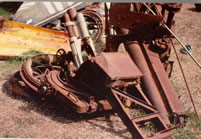
|
|||||||||||||||||||||||||||||||||||||||||||||||||||||||||||||||||||||||||||
Historical Specifics:
No 34132, it was one of two which were at Nhill in Victoria, both with the 1917 direct fire carriage. There was also a C96n/a, a late war rebuild example converted to a Nankampf gun with the axle relocated behind the shield, a counterweight added to the rear of the trail, a new hand brake system and all the seat fittings removed from the shield. The memorial was bulldozed for road widening in the 1960s, they languished in a scrap yard for over a decade. This minenwerfer was acquired in 1982. The others went to a collector in Victoria.
Of all the members in the Minenwerfer family, the light 7.5cm version was the least spectacular but at the same time the most important. It was used everywhere, and was the weapon that supported the German Infantry in all situations, especially during trench fighting, when traditional flat trajectory weapons often were at an disadvantage.
When the war started, the light Minenwerfer (Mine thrower) existed only in prototype form. By 1916, trials and battle experience had resulted in the construction of a new type of Light Minenwerfer, the LMW n.A. (neuer Art, new type). This had a bedding that was circular at the front and square at the back, and had also a traverse plate, making it possible to move the piece 360 degrees around. Like the earlier type, it could be fitted with wheels, and be carried by special poles or simply dragged by men equipped with a special harness.

- Private Collection
75mm Mortar Serial Number 34132
- Private Collection
75mm Mortar Serial Number 34132

